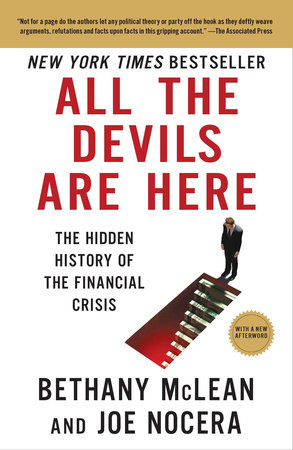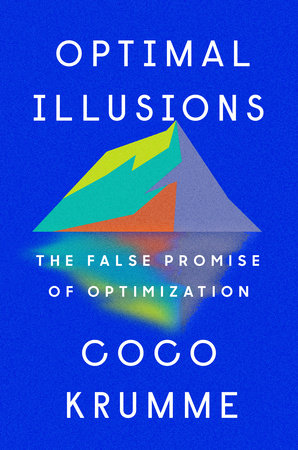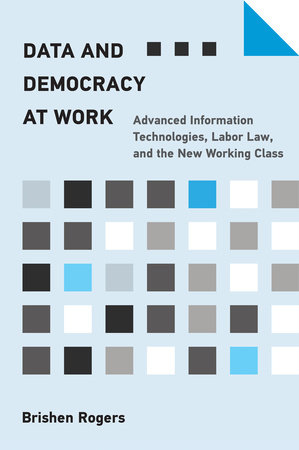Quick Summary
One Sentence Summary
“All the Devils Are Here” delves into the complex web of actions and decisions that led to the 2008 financial crisis, exposing the deep flaws in the financial system and the key players involved.
Big Idea
The book uncovers the systemic issues and moral failings in the financial and regulatory systems that precipitated the global financial crisis, revealing how greed, ignorance, and a lack of oversight allowed the crisis to unfold.
Five Key Ideas
- Complex Financial Instruments: It details how complex financial instruments like mortgage-backed securities and derivatives contributed to the crisis.
- Regulatory Failures: The book highlights the failure of regulatory agencies to identify and mitigate risks in the financial system.
- Corporate Greed: It exposes how corporate greed and shortsightedness among top executives and institutions played a role.
- Misplaced Trust: The narrative shows how misplaced trust in mathematical models and ratings agencies masked underlying risks.
- Interconnectedness: It underscores the interconnectedness of global financial institutions and how this facilitated the spread of the crisis.
Actionable Advice
Understand the importance of financial literacy and awareness. Advocate for transparency and accountability in financial institutions and regulatory bodies.
About the Author
Joe Nocera is a seasoned journalist known for his work on business and finance, while Bethany McLean is a celebrated financial writer, famous for her role in uncovering the Enron scandal.
Read Next
For further understanding of financial crises and corporate failures, consider reading:
- “The Smartest Guys in the Room” by Bethany McLean and Peter Elkind, detailing the Enron scandal.
- “Too Big to Fail” by Andrew Ross Sorkin, providing another perspective on the 2008 crisis.
- “Flash Boys” by Michael Lewis, exploring the impact of high-frequency trading on financial markets.
In Depth
Complex Financial Instruments
The 2008 financial crisis was a web of intricacies, with complex financial instruments at its core. “All the Devils Are Here” sheds light on how these complicated products, especially mortgage-backed securities (MBS) and derivatives, played a pivotal role in the crisis.
Mortgage-backed securities are essentially bundles of home loans, sold to investors as bonds. Initially, they seemed like a win-win: homeowners got loans, banks offloaded risk, and investors got steady income. But, as the book reveals, the reality was far grimmer. Banks started lowering lending standards to create more MBS, leading to a surge in risky, subprime mortgages.
The book gives a detailed example of how these risky practices unfolded. It discusses Countrywide Financial, a company that became synonymous with subprime lending. Countrywide, driven by profit and growth, began issuing mortgages to almost anyone, disregarding their ability to pay. These subprime loans were then packaged into MBS and sold to investors. The authors state, “Countrywide’s standards had fallen so far that it was essentially giving money away.” This simple sentence encapsulates the reckless abandon with which financial institutions operated.
Then there were derivatives, like Credit Default Swaps (CDS), which are essentially insurance policies on these securities. These too were meant to reduce risk but ended up creating a false sense of security. When the housing bubble burst, both MBS and CDS became ticking time bombs. Investors and banks realized the securities they held were backed by bad loans, but by then, the damage was extensive.
A telling quote from the book emphasizes this: “The financial system had created a web of interrelated obligations that was so complex that no one, not the executives, not the regulators, and certainly not the investors, understood what would happen when the web was pulled apart.”
What’s striking is how these complex products masked the underlying risks. Ratings agencies, often seen as the guardians of financial integrity, stamped these risky MBS with high ratings, further fueling the crisis. The book points out that these agencies were deeply entwined with the institutions they were supposed to oversee, leading to a catastrophic lapse in judgment.
In essence, “All the Devils Are Here” paints a vivid picture of how these complex financial instruments, created to spread and mitigate risk, ended up doing the exact opposite. They became tools of mass financial destruction, driven by greed and enabled by a lack of oversight. The crisis was not just a failure of individual institutions but a systemic collapse, a domino effect triggered by the very products that were supposed to stabilize the financial system.
Regulatory Failures
The 2008 financial crisis wasn’t just a tale of complex financial products; it was also a story of monumental regulatory failures. “All the Devils Are Here” exposes how regulatory bodies, entrusted to oversee and maintain stability in the financial system, failed spectacularly.
The book points out how these failures weren’t merely oversights; they were systemic. Regulators, such as the Securities and Exchange Commission (SEC) and the Federal Reserve, had become complacent. They were either unaware of the risks brewing in the financial system or chose to ignore them.
A detailed example involves the SEC’s Consolidated Supervised Entities (CSE) program. This program was supposed to oversee the investment banks, but it failed miserably. The book narrates how the SEC, under this program, allowed banks like Lehman Brothers to ramp up their leverage. Higher leverage meant higher risks. The authors describe this situation succinctly: “The SEC’s watchmen were essentially asleep at the switch.”
Another glaring instance of regulatory failure was the Federal Reserve’s reluctance to regulate the subprime mortgage market. Despite clear signs of malpractice and predatory lending, the Fed, under Alan Greenspan, chose a hands-off approach. The rationale was that the market would self-correct. This laissez-faire attitude towards regulation had devastating consequences.
The authors highlight this with a potent quote: “The belief that the markets were self-correcting meant that they ignored the building of the bubble and only saw the benefits of innovation, not its dangers.” This statement captures the essence of the regulatory mindset that contributed to the crisis.
The book also sheds light on the inadequate regulation of over-the-counter derivatives, like Credit Default Swaps. These products were largely unregulated, operating in the shadows of the financial system. When the crisis hit, the lack of transparency in this market exacerbated the panic and confusion.
Furthermore, the interagency rivalry and turf wars further impeded effective oversight. Different regulatory bodies, instead of collaborating, often found themselves in conflicts over jurisdiction. This lack of cohesion and unity in approach created regulatory gaps that financial institutions exploited.
In conclusion, “All the Devils Are Here” meticulously lays out how regulatory failures were not just about what the agencies did wrong; it was also about what they didn’t do. The regulatory agencies, blinded by ideological beliefs in market self-correction and hamstrung by internal conflicts, failed to see the warning signs and act decisively. These failures, as the book powerfully illustrates, were as instrumental in precipitating the crisis as the actions of the financial institutions themselves.
Corporate Greed
“Corporate Greed” stands out as a central theme in “All the Devils Are Here,” underlining how unchecked ambition and profit-seeking behaviors of corporate leaders played a significant role in the 2008 financial crisis. The book meticulously details how the pursuit of short-term gains and disregard for long-term consequences by financial institutions laid the groundwork for one of the worst financial meltdowns in history.
A prime example highlighted in the book is the case of Lehman Brothers. The authors delve into the leadership of CEO Dick Fuld, whose relentless pursuit of profits led to reckless decisions. Lehman Brothers, under Fuld’s direction, heavily invested in subprime mortgages and engaged in high-risk activities, ignoring the obvious warning signs of a housing bubble.
The authors describe this blind pursuit of profits with a telling quote: “In the race to keep up with the competition, Lehman, like many others, had begun to take more and more risks.” This line encapsulates the underlying issue of corporate greed that was rampant across the financial sector.
The narrative also touches on the bonus culture prevalent in Wall Street firms. Bonuses were often tied to short-term performance, incentivizing risky behavior. Executives were more focused on inflating their bonuses rather than considering the long-term health of their companies. This culture of greed didn’t just exist in isolated cases; it was endemic across the financial industry.
Another stark example is Angelo Mozilo, the CEO of Countrywide Financial. The book portrays Mozilo as a key figure who aggressively pushed his company into risky subprime lending. His focus was on growth and market share, even if that meant compromising on lending standards. Countrywide’s reckless lending practices, motivated by Mozilo’s vision of dominance, significantly contributed to the crisis.
The authors poignantly state, “The system had evolved in such a way that it rewarded the appearance of profitability, not actual profitability.” This statement vividly highlights the systemic issue of corporate greed, where appearances and short-term profits overshadowed genuine, sustainable growth.
Moreover, the book doesn’t shy away from discussing how the compensation structures in these financial firms not only rewarded risky behavior but also encouraged a disconnect between actions and consequences. Executives could make risky bets, reap immediate rewards, and often leave the long-term fallout for others to deal with.
In essence, “All the Devils Are Here” paints a detailed picture of how corporate greed, manifested in the actions of top executives and the cultures of their institutions, was a driving force behind the 2008 financial crisis. The pursuit of profit, often at any cost, led to a series of decisions and practices that collectively jeopardized the stability of the financial system. The book serves as a stark reminder of the consequences when corporate greed goes unchecked and short-term gains are prioritized over long-term stability.
Misplaced Trust
“Misplaced Trust” emerges as a critical theme in “All the Devils Are Here,” illustrating how blind faith in mathematical models and rating agencies played a significant role in fueling the 2008 financial crisis. The book delves into how this unwarranted trust led to a false sense of security, masking underlying risks and vulnerabilities.
A striking example the authors explore is the widespread reliance on complex mathematical models, particularly by Wall Street firms. These models were designed to predict risks and guide investment strategies. However, they were based on historical data and assumptions that failed to account for unprecedented market conditions.
The book narrates the case of AIG’s Financial Products division, which relied heavily on models to gauge the risk of its Credit Default Swaps (CDS). These models indicated that the risk was minimal, fostering a misplaced sense of confidence. But when the housing market collapsed, the models’ predictions proved disastrously wrong.
The authors encapsulate this issue with the quote, “The problem wasn’t the math; the math was impeccable. The problem was what the math represented, and what it left out.” This succinctly conveys how the blind trust in these models overlooked their inherent limitations and the real-world complexities.
Additionally, the book highlights how the trust placed in rating agencies contributed to the crisis. Agencies like Moody’s and Standard & Poor’s were trusted to provide unbiased assessments of financial products, including mortgage-backed securities. However, these agencies were deeply entwined with the very institutions they were rating, leading to conflicts of interest.
An example cited in the book is how rating agencies continued to give high ratings to mortgage-backed securities, even when the housing market was showing signs of distress. These high ratings were partly driven by the agencies’ business models, where they were paid by the issuers of the securities they rated.
The authors critically point out, “The ratings agencies were supposed to be gatekeepers, but they opened the gates wide.” This statement highlights how the misplaced trust in these agencies allowed flawed financial products to flood the market, amplifying the crisis.
In summary, “All the Devils Are Here” sheds light on how misplaced trust in mathematical models and rating agencies significantly contributed to the 2008 financial crisis. The blind faith in these models and agencies, without proper scrutiny and understanding of their limitations, led to a dangerous underestimation of risks. The book serves as a cautionary tale about the perils of relying too heavily on models and external validations without recognizing their potential flaws and biases.
Systemic Interconnectedness
In “All the Devils Are Here,” the theme of “Systemic Interconnectedness” underlines how the deeply intertwined nature of financial institutions and products contributed to the widespread impact of the 2008 financial crisis. The book elucidates that it wasn’t just individual entities or products failing; it was the interconnectedness that amplified the crisis, turning individual failures into a systemic collapse.
A detailed example from the book involves the fall of Lehman Brothers. This wasn’t just the failure of a single investment bank; it had far-reaching consequences. Lehman Brothers was interconnected with other financial institutions through loans, investments, and complex financial products like derivatives. Its collapse sent shockwaves throughout the global financial system, illustrating the dangerous domino effect inherent in such interconnectedness.
The authors describe this situation: “Lehman’s failure proved that in the tightly wound skein of modern finance, the failure of one could lead to the failure of all.” This quote encapsulates the perils of systemic interconnectedness, where the failure of one entity can trigger a chain reaction.
Furthermore, the book discusses how the securitization of mortgages contributed to this interconnectedness. Banks would originate mortgages, bundle them into securities, and sell them to investors worldwide. These mortgage-backed securities linked homeowners in the United States to investors globally. When the U.S. housing market collapsed, it wasn’t just American banks that suffered; the impact was global.
Another illustration of this interconnectedness was the role of Credit Default Swaps (CDS). These financial derivatives, meant to act as insurance against defaults, tied companies together in a web of mutual obligations. AIG, for example, sold vast amounts of CDS, effectively insuring securities based on risky mortgages. When the mortgages began to default, AIG faced enormous liabilities, impacting all the institutions that relied on its credit protection.
The book emphasizes this point with a poignant quote: “The world of finance had become so interconnected that trouble anywhere could lead to trouble everywhere.” This line vividly portrays how the interlinked nature of modern finance turned local problems into global crises.
In essence, “All the Devils Are Here” lays bare the reality of systemic interconnectedness in the financial world. It wasn’t just the failure of individual products or institutions; it was how they were woven together in a complex tapestry that made the financial system vulnerable. This interconnectedness meant that the shock in one part of the system could quickly spread, leading to a crisis of unprecedented scale. The book serves as a stark reminder of the dangers of such interconnectedness and the importance of understanding and managing these linkages to prevent future financial catastrophes.
Actionable Advice
-
Stay Informed: Regularly educate yourself about financial markets and products. Understand the risks associated with investments.
-
Diversify Investments: Don’t put all your eggs in one basket. Spread your investments across different asset classes to mitigate risk.
-
Scrutinize Financial Advisers: Carefully choose financial advisers. Ensure they have a solid track record and transparent practices.
-
Avoid Over-leverage: Be cautious with borrowing for investments. High leverage increases financial risk.
-
Monitor Regulatory Changes: Keep an eye on financial regulatory reforms and understand how they impact your investments.
-
Question Assumptions: Don’t take financial models and ratings at face value. Understand their assumptions and limitations.
-
Prepare for Market Fluctuations: Accept that markets are unpredictable. Plan for potential downturns.
-
Evaluate Long-term Impacts: Consider the long-term consequences of financial decisions, not just short-term gains.
-
Support Ethical Practices: Choose to invest in companies with responsible and ethical business practices.
-
Stay Cautious of Trends: Be wary of following financial trends blindly. Conduct your own research and analysis.
About the Author
Joe Nocera is a seasoned journalist and author, known for his deep dives into business and finance. He has a long-standing career with notable contributions to The New York Times and Bloomberg View. Nocera’s work often explores the intricacies of corporate America, financial markets, and their socio-economic impacts. His writing style blends investigative rigor with engaging narratives. He co-authored “All the Devils Are Here” with Bethany McLean, offering a meticulous account of the 2008 financial crisis. Nocera’s belief in holding financial institutions accountable and promoting ethical practices is evident in his work. He champions transparency and consumer protection in the financial industry, consistently advocating for a more informed and cautious approach to investing. His other notable works include “A Piece of the Action: How the Middle Class Joined the Money Class,” reflecting his interest in financial literacy and accessibility. Nocera’s dedication to unearthing and explaining complex financial stories makes him a respected voice in business journalism.
Read These Next
You might like these similar books
- “The Big Short: Inside the Doomsday Machine” by Michael Lewis
- “Too Big to Fail: The Inside Story of How Wall Street and Washington Fought to Save the Financial System—and Themselves” by Andrew Ross Sorkin
- “The Smartest Guys in the Room: The Amazing Rise and Scandalous Fall of Enron” by Bethany McLean and Peter Elkind
- “Liar’s Poker” by Michael Lewis
- “When Genius Failed: The Rise and Fall of Long-Term Capital Management” by Roger Lowenstein
FAQ
Q: What is the main focus of “All the Devils Are Here”?
A: The book delves into the causes and events leading up to the 2008 financial crisis.
Q: Who are the authors?
A: Joe Nocera and Bethany McLean co-authored the book.
Q: Is the book suitable for those without a finance background?
A: Yes, it’s written in an accessible manner for a general audience.
Q: Does it cover specific financial institutions?
A: Yes, it discusses institutions like Lehman Brothers and AIG in detail.
Q: Is the book fact-based or opinion-driven?
A: It’s primarily fact-based, offering a detailed account of events and practices leading to the crisis.
Q: How long is the book?
A: The book is moderately lengthy, offering an in-depth exploration of the topic.
Q: Will reading this book help in understanding the current financial market?
A: While focused on the 2008 crisis, it provides insights that are valuable for understanding broader financial market dynamics.







